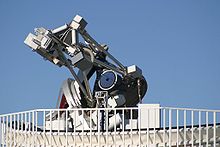Dutch Open Telescope
|
Telescope Dutch Open Telescope |
|
|---|---|

|
|
| The Dutch Open Telescope with the hood closed | |
| Type |
Reflecting telescope, focal length : 2.0 m, resolution: 0.071 arcsecond / pixel |
| Location |
Roque de los Muchachos Observatory
|
| height | 2350 m |
| Geographic coordinates | 28 ° 45 '34.7 " N , 17 ° 52' 52.8" W |
| wavelength | Optically |
| Aperture | 0.45
|
| construction time | 1997 |
| Specialty | Mounted in the open steel framework |
The Dutch Open Telescope , also called DOT for short , is an optical solar telescope with a 45-centimeter primary mirror and is part of the Roque-de-los-Muchachos observatory on La Palma in the vicinity of the 1-meter Swedish Solar Telescope .
It achieves an angular resolution of 0.2 arc seconds for a sustained period of time. The so-called despeckle mechanism is used with the DOT to further optimize the images . One of his achievements was the inclusion of the Venus transit in the year 2004 .
history
Until 2007, the telescope was largely funded by the Institute of Astronomy and the Faculty of Physics and Astronomy of the University of Utrecht and other institutions before it became part of the European Northern Observatory .
Cameras
The DOT has six cameras, each with a different optical filter . All filters can be used in parallel, which enables simultaneous observation in the range of different wavelengths and thus ensures optimal comparability of the results. In addition, the bandwidth of some of the filters can be adjusted so that observations at different points on the spectral lines are possible.
Open structure
The DOT is an open telescope in which the tower, mount and telescope are unprotected and exposed to the wind during observation. As a result, a relatively constant temperature can be achieved on the mirror, which significantly reduces disturbances caused by air turbulence due to temperature differences ( seeing ). Conventional telescope designs in solar telescopes often have the problem that warm air from the ground, which has been heated by the sun , rises along the tower and mirror, which is harmful to the image quality.
A disadvantage of this design is that the support structure must be very rigid so that it does not move in the wind. Usually this function is performed by a solid tower or dome shielding the telescope. The optics of the telescope of the DOT are located two meters in front of the main mirror, to prevent blurring of the image, the cameras are very stable and can be adjusted to the micrometer.
Roof construction
Another new feature of the DOT is its roof construction, which is made from a special polymer fiber. The roof keeps its shape when it is stretched and shows no signs of fatigue even after a long period of time. Each of the individual saddle-shaped roof parts is under tension as soon as the roof is closed, which increases stability.
Light granulation
The Despeckle - algorithm makes it possible to resolve objects down to the diffraction-related limits of the telescope and so to achieve optimal image quality, the less strongly by the Seeing is impaired. During the process, 100 images of the same object are recorded with an extremely short exposure time (for example a granular structure of the sun), in each case at a time interval in which the atmospheric properties have already changed significantly, but not the properties of the observed object.
Then the image on a high-performance computer, a 35- is Dual Core - Xeon - computer cluster , the Despeckle algorithm improved with the help of statistical methods. Before the summer of 2005, this calculation took months, the new computer network reduced the calculation time to the length of one night.
Web links
- Dutch Open Telescope (DOT) , website of the telescope
- DOT Database , recordings of the DOT at the University of Leiden
- Instituto de Astrofísica de Canarias - IAC , website of the operator of the facility
- AG de Wijn: A parallel implementation of speckle image reconstruction: Toward parallel speckle reconstruction for the Dutch Open Telescope. October 17, 2002, Astronomical Institute, Utrecht (PDF, English, 397 kB)
Individual evidence
- ↑ DOT and the 2004 Venus transit , DOT website (accessed November 5, 2015)
- ↑ DOT at a glance , DOT website (accessed November 5, 2015)
- ↑ DOT Tomography , DOT website (accessed November 5, 2015)
